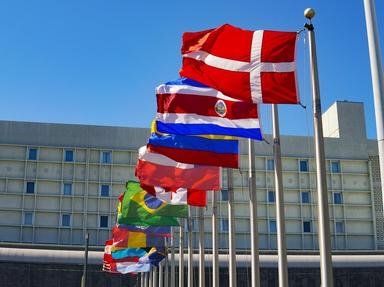Quiz Answer Key and Fun Facts
1. The title of the Lord Lyon King of Arms is applied to the officer responsible for all heraldic matters that appertain to which country or region of the United Kingdom?
2. 'Gules, three dexter arms cojoined and flexed in triangle or, hands clenched proper'. There is a clue to the answer in there - to which family would you expect these arms (no pun intended!) to belong?
3. Under what circumstances would it be permissible for unrelated families to be granted and bear identical arms?
4. Imagine, for one moment, that you are a fourteenth century herald. You have been charged with the provision of arms to the legitimate and first born son of a duke. What changes would you make to his father's arms prior to them being granted to his son?
5. As we have seen, a mark for cadency on the arms of the eldest, legitimate son takes the form of a label in the chief. Why would this label, which is a permanent addition to the arms of the eldest son, remain blazoned on the arms for the entire life of their holder?
6. All legitimate male offspring, up to the ninth son, are granted a mark for cadency. Specifically, where on a QUARTERED shield would a mark like this be placed?
7. We have, until now, been concerned with differencing or marks of cadency for legitimate offspring. There have, over the centuries, been a number of methods used to difference arms for illegitimacy. Of the following, which was more usually placed on a shield to denote illegitimacy?
8. An honourable addition to armorial bearings, whether granted by grace or for merit, may take the form of a charge added to the arms, a complete coat of arms to be borne as a quartering or an additional crest. By what term are these additions known?
9. Toward the end of the thirteenth century, heraldry began to develop a significant difference from the its purpose of identifying an individual. Arms were seen as a means of illustrating and demonstrating alliances through marriage, the possession of more than one lordship by a single man, or of the holding of a royal office. By what name is the practice of this grouping or composition known?
10. Retainers and adherents to any particular family that were entitled by display armorial bearings, would be entitled, during the execution of their normal duties, to use and display these arms?
11. The subject of women in heraldry is frequently overlooked. As we have seen, legitimate sons bear the arms of their father with a mark of cadency that signifies their position within the hierarchy. Would it be safe to assume that females also display a mark of cadency relative to their position within the family?
12. What was the name given to the early method of impalement, now abandoned, where the arms of a husband and wife were displayed on the shield?
13. After the accession of which king does it appear to have become the rule that, in England, no person shall be created a knight except by the King or his personal representative?
14. To the head of which family, the subject of intense media attention around the world during 2011, does the following blazon belong? 'Per pale azure and gules, a chevron or cotised argent between three acorns slipped and leaved or'
15. And finally, something less taxing to finish. Which of the following British Orders of Chivalry is the most senior?
Source: Author
SisterSeagull
This quiz was reviewed by FunTrivia editor
stedman before going online.
Any errors found in FunTrivia content are routinely corrected through our feedback system.
